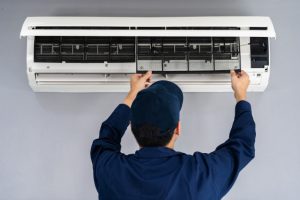Air conditioner. Is it time to replace?
When is the time to replace the air conditioner?

Replace the air conditioner: Summer is coming and that means the weather is HOT coming. Is your current air conditioner ready for the challenge? If not, now is the perfect time to get it fixed, repaired, or replaced. Here is the information you need to make sure your home is cool and comfortable in the coming months.
How old is my air conditioner?
An air conditioner guarantees you an average of 10 to 15 years of service. So one of the first things you will want to do is determine the age of your current cooling system. Whether it is near the end of its useful life. If you bought the system yourself, you shouldn’t have too much trouble figuring out its age. Especially if you’re the organized type and have filed or scanned the original receipt.
However, in case the air conditioner was already installed before you bought your home, you will need to do some detective work. If you are lucky, you will easily find the information you need on the metal nameplate. Attached to the external air conditioning condenser unit. Where the production date is often written as month and year.
If the date is not clear, photograph the nameplate or note the make, model and serial number listed. You can then use this information to track when the unit was built, by searching online or by asking an experienced HVAC professional.
Repair vs. Replace the air conditioner?
When deciding whether to repair or replace your air conditioner, the age of the appliance plays a crucial role. No, we’re not trying to be anti-ageing here, but an older air conditioning system has at least two hits against it:
-
Can use R22 refrigerant (also known as “Freon”)
The Canadian government is phasing out this dangerous ozone-depleting substance. Eventually, it will also be illegal to use the existing R22. So what does this phasing out mean to you? You may also smell refrigerant coming from your air machine.
If you have a coolant leak and need to top up your system, you won’t be able to buy the R22 you need. And ultimately, you won’t be allowed to run your R22 based A / C.
-
It probably wastes energy
The terms of the ratio measures the A / C energy consumption. Between the BTU of cooling energy and the watt-hour of electricity consumption (Seasonal Energy Efficiency Ratio). The old SEER ratings were a low of 10; which has now increased to 13 or better.
A modern, energy efficient unit will reduce your carbon footprint, as well as save money on electricity bills. If you opt for air machine replacement, whether you want a ductless or central air conditioner, seek certification.
Another factor (which isn’t exclusive to older units) is how much you’re spending on repairs. When your air conditioner costs you a fortune in repairs, it may be time to install a new air conditioner.
However, if you need to do another expensive repair in a year or two (or 5) suddenly that short-term repair will cost you more than if you had just replaced the drive to begin with! Plus, that new drive will come with a warranty and expectation of trouble-free operation for a decade.
Last but not least, consider the comfort factor of your home. If the air conditioning leaves the indoor air clammy and sticky, cools unevenly, or is excessively noisy, it’s probably time to look into a better model.
How to keep it running efficiently?
Whatever the age or SEER rating of your air conditioner, there are some practical steps you should take to keep it running at peak efficiency and avoid unnecessary repairs, namely:
Clean or replace the air filters. Do this every 30 days for standard fibreglass filters and every 5-6 months for more expensive pleated filters.
Regular program adjustments. Treat your cooling system to a professional tune-up every year, before you start using it in the spring or fall when you’re ready to shut it down for the season. Call now for air conditioner repair. Is your air conditioner not cooling properly or running all the time? Do not delay. Contact Emergency Plumber Stafford for expert repair today, before a small problem turns into a bigger and more complicated one.
